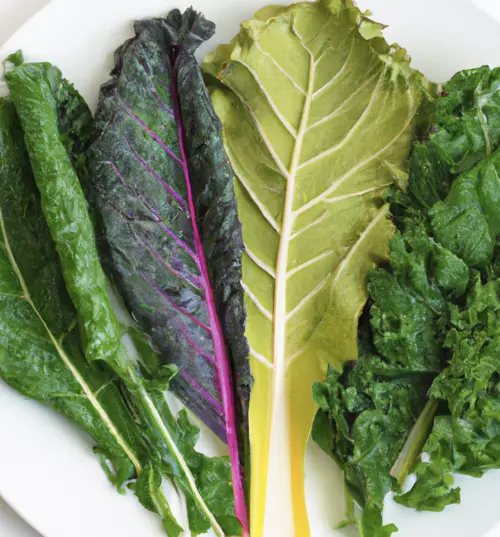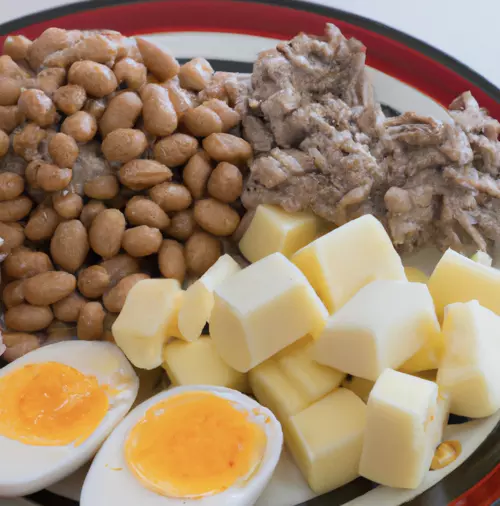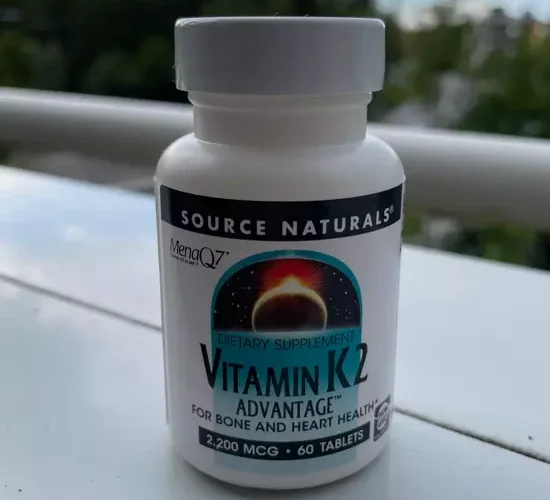Vitamin K is a group of fat-soluble vitamins that the body needs for blood clotting, bone metabolism, and regulating blood calcium levels.
Vitamin K was first discovered in 1929 by Danish scientist Henrik Dam. He was studying cholesterol in chicks and noticed that they developed hemorrhages and excessive bleeding when fed a diet low in cholesterol. This led him to conclude that a second compound, which he initially called the “coagulation vitamin,” was necessary for proper blood clotting. This substance was later renamed Vitamin K, after the German word “Koagulation.”
Later, in 1939, Edward Adelbert Doisy, an American biochemist, was able to isolate Vitamin K and determine its chemical structure. For their work on Vitamin K, both Dam and Doisy were awarded the Nobel Prize in Physiology or Medicine in 1943.
The two main types of vitamin K that we typically consume are vitamin K1 and vitamin K2.
Vitamin K1, also known as phylloquinone, is a type of Vitamin K that is primarily found in leafy green vegetables, such as kale, spinach, broccoli, and brussels sprouts. It is also present in some fruits like kiwi and avocado. Vitamin K1 is the main dietary form of Vitamin K.
The primary role of Vitamin K1 in the body is to assist with blood clotting. When you get a cut or a wound, the body uses Vitamin K1 to activate certain proteins that initiate the clotting process and prevent excessive bleeding.
A deficiency in Vitamin K1 is generally rare in adults, as the body is able to recycle its existing Vitamin K. However, newborns are at risk of Vitamin K1 deficiency, as their gut does not contain the bacteria that synthesize Vitamin K2 yet, and the placenta has a low transmission rate of Vitamin K from mother to baby. This is why it’s common practice in many countries to give newborns a Vitamin K1 injection.
Vitamin K2, also known as menaquinone, is another form of Vitamin K. Unlike Vitamin K1, which is primarily found in green leafy vegetables, Vitamin K2 is mainly found in fermented foods, animal products, and certain types of cheese. Some examples include natto (a fermented soybean dish popular in Japan), sauerkraut, and some types of dairy products like cheese and yoghurt. Some bacteria in the human gut can also convert a portion of K1 to K2.
There are several subtypes of Vitamin K2, designated as MK-4, MK-7, MK-8, MK-9, etc., with MK-4 and MK-7 being the most well-studied. MK-4 is found in animal foods, while MK-7 is primarily in fermented foods.
Vitamin K2 plays several roles in the body. One of its primary functions is to assist in the metabolism of calcium in the body. It activates proteins that help to keep calcium in bones and teeth and out of arteries and soft tissues. Some research suggests that Vitamin K2, especially MK-7, may be beneficial for bone health, cardiovascular health, and potentially other areas like cancer and inflammation, but more research is needed in these areas.
Vitamin K2 can interact with certain medications, like blood thinners. Additionally, as Vitamin K2 is often less prevalent in the diet compared to Vitamin K1, some people may choose to take it as a supplement.
It’s widely believed that the substance Dr. Weston A. Price referred to as “Activator X” in his nutritional studies is indeed Vitamin K2. Price was a dentist from the early 20th century who did extensive research on nutrition and its impact on dental and physical health.
In his studies, Price observed a fat-soluble substance in the diets of certain communities which seemed to have protective effects against tooth decay and other health problems. He named this substance “Activator X”. He found it in certain foods like grass-fed dairy products, fish eggs, and organ meats – foods that are known today to be high in Vitamin K2.
Modern researchers have made connections between Price’s “Activator X” and Vitamin K2, particularly due to the roles that K2 plays in bone and cardiovascular health, as well as the similar food sources. However, the identification of Activator X as Vitamin K2 is based on a confluence of evidence rather than a definitive proof.
The recommended dietary allowance (RDA) for Vitamin K does not distinguish between Vitamin K1 and K2; it’s provided for Vitamin K in general. For adult men it is 120 micrograms per day, and for adult women, it’s 90 micrograms per day.
Both vitamins K1 and K2 are fat-soluble, meaning they require dietary fat to be absorbed properly. Thus, it’s beneficial to consume them alongside foods that contain some healthy fats, such as avocados or olive oil.
Our gut bacteria play a crucial role in the production and absorption of Vitamin K2. While Vitamin K1 is primarily obtained from dietary sources like leafy green vegetables, our gut bacteria have the ability to convert some of the Vitamin K1 into Vitamin K2.
Specifically, certain strains of bacteria in our intestines, such as Bacteroides and Escherichia coli, have the enzymatic capability to convert Vitamin K1 into its active form, Vitamin K2. This conversion process involves the addition of side chains to the Vitamin K1 molecule, resulting in different subtypes of Vitamin K2.
Once the gut bacteria convert Vitamin K1 into Vitamin K2, it becomes available for absorption by the body.
Vitamin K also works synergistically with several other nutrients:
Vitamin D: Both vitamins play crucial roles in maintaining bone health. Vitamin D aids in the absorption of calcium, and vitamin K helps direct the calcium to the bones and teeth where it’s needed, instead of allowing it to deposit in soft tissues and arteries. A balance between these two vitamins is essential.
Calcium: As mentioned above, Vitamin K helps direct calcium to where it’s needed in the body. Having sufficient Vitamin K can therefore help enhance the benefits of calcium for bone health.
Magnesium: Some research suggests that magnesium may support the actions of vitamin K in the body. They both play a role in bone health and cardiovascular health.
Here are some foods that are particularly high in Vitamin K1:
- Kale: 1 cup (240 ml) of raw kale contains about 470 micrograms of vitamin K. To reach the RDA for men, you would need to consume approximately 1/4 cup of raw kale.
- Mustard Greens: 1 cup of raw mustard greens contains about 280 micrograms of vitamin K. To reach the RDA, you would need to consume a bit less than 1/2 cup of raw mustard greens.
- Swiss Chard: 1 cup of raw Swiss chard contains about 300 micrograms of vitamin K. To reach the RDA, you would need to consume approximately 2/5 cup of raw Swiss chard.
- Spinach: 1 cup of raw spinach contains about 145 micrograms of vitamin K. To reach the RDA, you would need to consume approximately 5/6 cup of raw spinach.

As for Vitamin K2, it is typically found in animal-sourced and fermented foods:
- Natto (fermented soybeans): A small packet of natto is approximately 40g and contains about 1000 micrograms of Vitamin K2. This is many times the RDA, so even a small portion of a packet would suffice.
- Goose Liver: 100 grams of goose liver contains about 369 micrograms of Vitamin K2. To reach the RDA, you’d need to consume approximately 32 grams of goose liver.
- Hard Cheeses: The content of vitamin K2 can vary, but let’s say the average hard cheese contains about 30 micrograms of Vitamin K2 per 100 grams. Therefore, you’d need to consume approximately 400 grams of hard cheese to meet the RDA.
- Egg Yolk: 1 egg yolk contains approximately 15-20 micrograms of Vitamin K2. This means you’d need to consume between 6-8 egg yolks to reach the RDA.

A few months ago, without taking Vitamin K2 as a supplement, I had a venous blood test for phylloquinone (vitamin K1, which is a good reflection of the overall vitamin K status in the body). The result showed 0.9 ng/ml, which is within the normal range (0.3 – 2.0 ng/ml). Thus, with a sufficiently balanced diet that includes various types of leafy greens, the use of additional Vitamin K2 as a supplement is most likely not necessary.
However, Dr. David Sinclair mentions that he takes vitamin K2. According to him, it is not very well known but is crucial as it protects the cardiovascular system from calcium deposits and directs the calcium into bones rather than arteries.
Disclaimer
The information provided in this article is for general informational purposes only. The content presented on this website should be considered solely as opinions and personal experiences. Read more

Hey folks, dont ovranalyze. Look, K2 is scinetifically validatd for boostin bone density, promotin growth, spcially when combined with D3 to enhnce absorbtion. Ur facial bones behave similar to other bones, so K2 helps create denser more defind jawline, cheekbones coz of improved calcium uptake. Not a magic pill for instant jaw reconstrction but sure does helps.
Adult height? Not much impacted, bt aids in height growth for kids n teens. People’s responses vary, so K2’s effectivness differs. As athlet, found it beneficial.
Discrediting K2 without personal experience? not cool. Efficacy of ny supplemnt is bout ur unique response, not just studies. Try see the impact, then form opinion. U won’t kno unless u try! Ladies, this can work for u too. cheers!